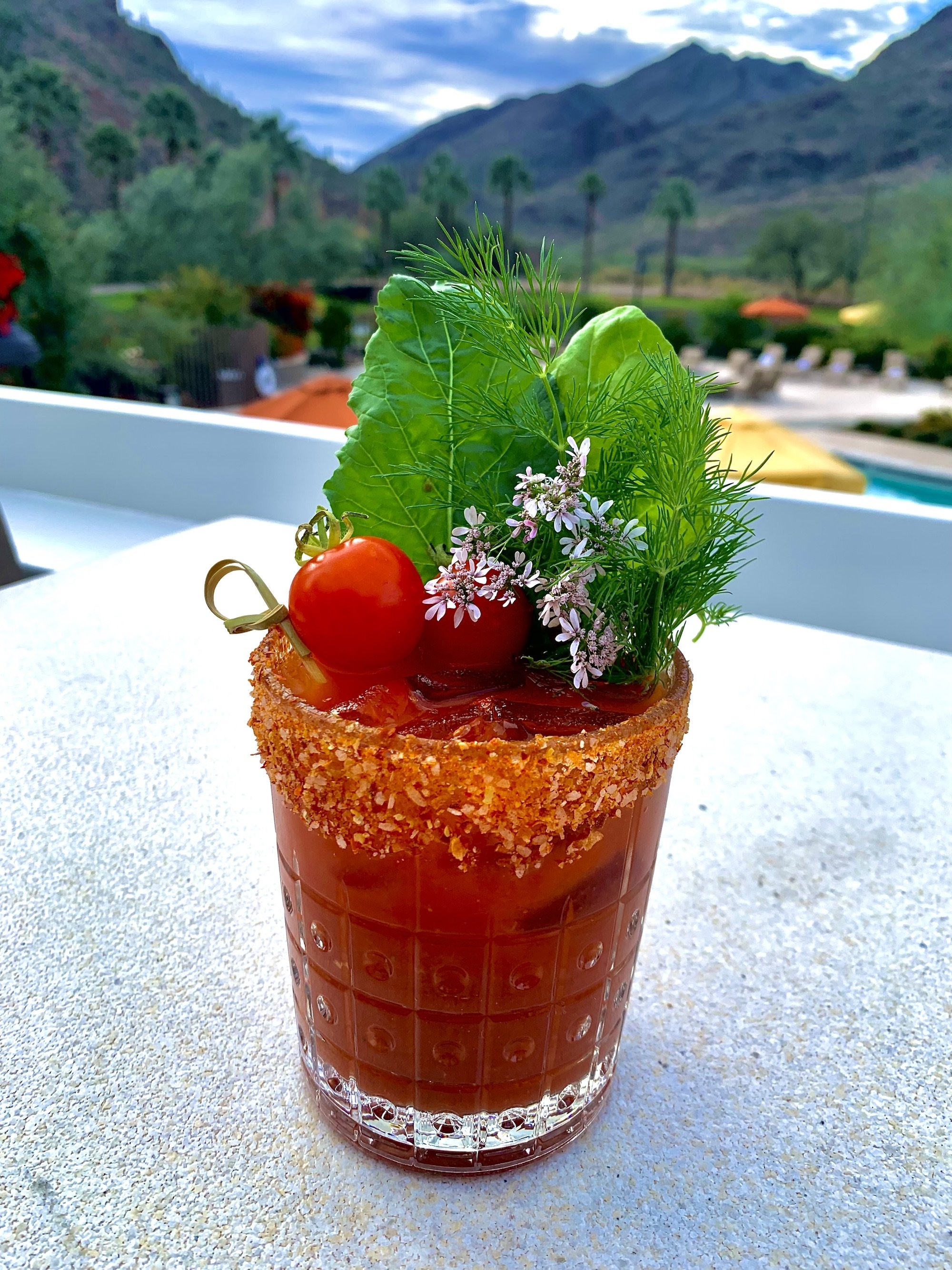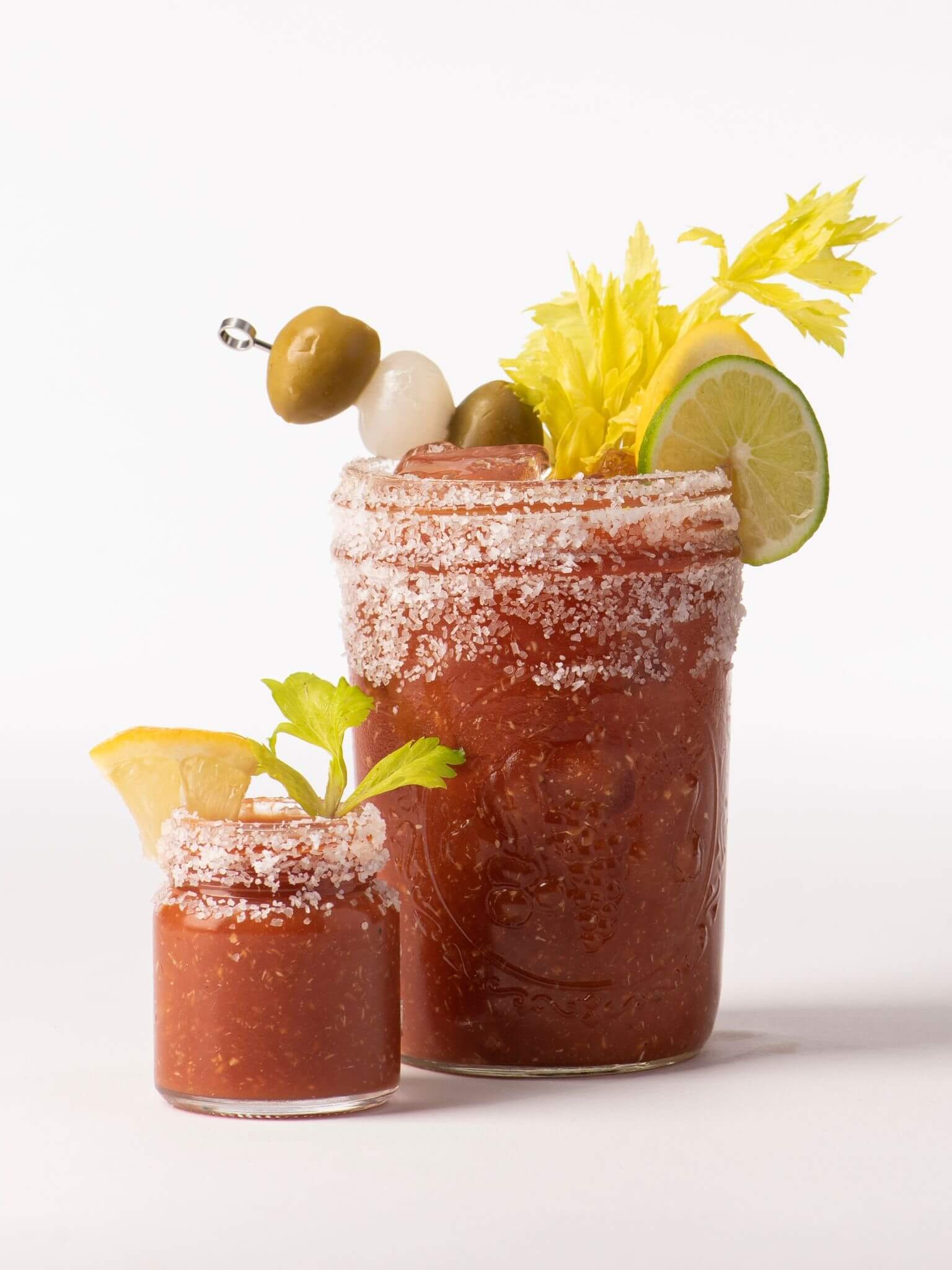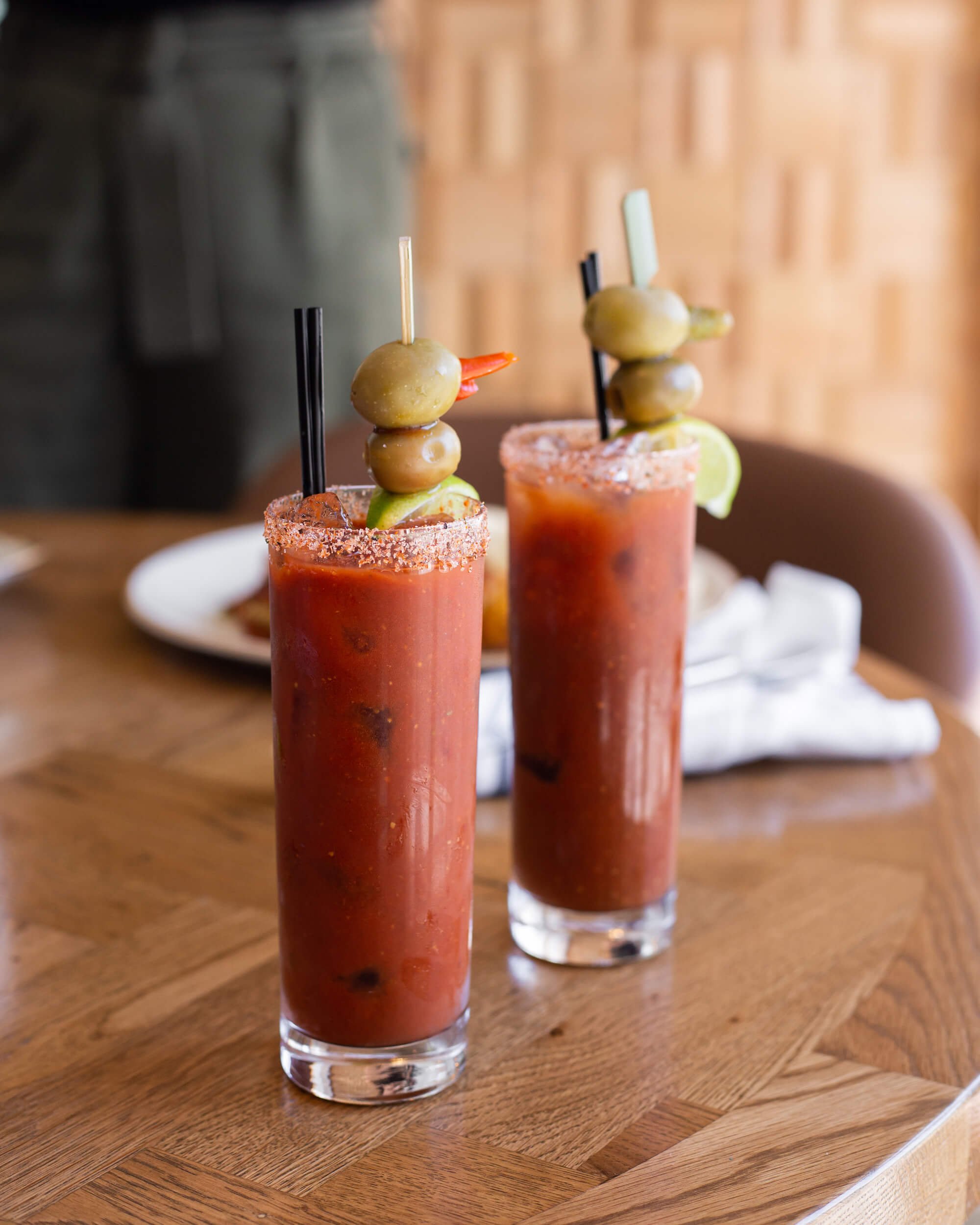7 Reasons a Bartender’s Bloody Mary Is Better Than Yours
Perhaps you’ve heard that a Bloody Mary is a good hangover cure? Whether that’s true or not (and depends on whether you believe in a little hair of the dog), January 1 is officially National Bloody Mary Day, likely in part due to the idea that ordering one at brunch after a night of partying on New Year’s Eve can only make you feel better—and keep the celebration going. As with many famous cocktails, its origins are a little hazy, but it’s likely the drink was created in 1921 at the New York Bar in Paris, and later became famous at the St. Regis New York’s King Cole Bar.
Bloody Mary History
Most sources agree that bartender Ferdinand “Pete” Petiot created the basic Bloody Mary cocktail in 1921 at the New York Bar in Paris, which later became Harry’s New York Bar. Originally named the Bucket of Blood, it also went by the name Red Snapper (although today that means a Bloody Mary with gin instead of vodka) and consisted of just tomato juice and vodka. Petiot later left Paris and started making more elaborate versions of the drink in the 1930s when he started working at the King Cole Bar inside the St. Regis Hotel in New York City. It was there that he added ingredients like salt, black and red pepper, Worcestershire sauce, and lemon juice.
Some attribute the name to the notorious Queen Mary I of England, whose nickname was Bloody Mary because she executed hundreds of Protestants in the name of Catholicism during her reign between 1553 and 1558.
Another possibility for the name origin comes from an article on the BBC about Harry’s New York Bar’s centennial celebration in 2011. In that piece, Bar Manager Alain Da Silva said, “The story is that there were a few customers, a few friends, and the bartender, Pete Petiot, made a cocktail for them with tomato juice and vodka. It got its name because one of the friends said, ‘It looks like my girlfriend who I met in a cabaret.’ The cabaret’s name was the Bucket of Blood and the name of the lady was Mary so it was very simple to call it a Bloody Mary.”
While the basic ingredients are simple—tomato juice and vodka—the cocktail today has a much longer list of possible ingredients, including pickle juice, olive brine, clam juice, celery salt, sugar, and horseradish, plus outlandish garnishes like bacon, shrimp, pickles, olives, celery, peppers, and more.
So what’s the secret to making one of the best hair of the dog cocktails? We talked to a few bartenders to find out.
1. Consider consistency and thickness
A Bloody Mary is one of the thicker cocktails around, but you want to consider exactly how thick you want yours to be. And, do you like chunks or want it smooth? These answers will determine what kind of tomato ingredient you should use as your base, and what else you should add to it.
Assuming you want a thicker base, New York City’s Who’s Jac W.? Chef/Partner Joel Reiss says, “I like to start out with the old school Campbell’s tomato juice. It starts out thick compared to other tomato juices and I love to use lemon zest instead of lemon juice—this also goes a long way keeping my Bloody Marys on the thicker side.”
Co-founder/beverage director for Lindens and Foxtail at Arlo Soho in New York City Gary Wallach says it’s safer to use canned tomatoes rather than fresh ones because they’re more consistent. Beverage Director Drew Hairston of Maydan in Washington, D.C., agrees, adding, “Don’t juice your own tomatoes unless they are at peak ripeness! Tomatoes are very acidic, and can add off-flavors to your drink if they aren’t in season.” He recommends using canned or bottles of tomato juice, like the one from Sacramento Foods.
Jennifer Colliau, Beverage Director for San Francisco’s BV Hospitality (Trick Dog, Bon Voyage!), adds, “Do not skimp on the quality of your tomato juice! You want one that is thick and rich so that when you add vodka, it doesn’t get too thin and dilute.” She also suggests pureeing pickled chilies to add to the texture (and flavor) even more.
You’ll also want to consider how other ingredients will change the texture of the cocktail. “Horseradish is an essential ingredient, but sometimes it makes the drink a bit too chunky,” says Jean-Paul Sabatier, partner and F&B director at Jane Jane in Washington, D.C. “Infusing vodka with fresh horseradish gives you all the horseradish flavor without the horseradish ‘chunkies.’”
Colliau agrees that other ingredients can alter the consistency; she recommends mixing any seasonings into the juice the day before serving in order to hydrate the dry spices and prevent a gritty texture.
2. Pair other veggie juices with tomato to create a complex flavor
Several bartenders don’t rely on just tomato juice for the base, adding in other juiced vegetables to round out the flavor. Lynnette Marrero, the co-founder Speed Rack; bar director of Llama Inn and Llama San in New York City, and the newly minted award-winner of the World’s 50 Best Bars Bartender’s Bartender 2021, makes red and green Bloody Marys and recommends adding some sweetness to an otherwise savory and salty drink via other veggies. “Beet juice is what I like to add to the mix for my Red Marys to add sweet and earthy flavors. In my Green Mary, I use some fresh-pressed green apples to add sweetness.”
Sabatier at Jane Jane says, “It’s important to use a good mix of fresh juices. When we initially launched our Bridge Menu, we had a house Bloody with fresh-pressed red bell pepper juice, fresh celery juice, and fresh lemon and lime juices mixed into the tomato base.”
At Castle Hot Springs, a resort about 50 miles north of Phoenix, Bar Manager Gavin Peña roasts a mix of vegetables from their on-site farm to add a slightly smoky flavor before juicing and adding them to his fresh tomato puree, while Hairston at Maydan recommends adding cilantro or parsley juice.
But whatever you do, don’t skimp on quality. “Never use poor quality vegetables. It will show no matter how much you try to cover it up,” says Adam Morgan of Husk in Nashville.
3. It’s all about balance
While the Bloody Mary is overall a savory drink, a good one takes balance into account, assuring that it’s not too salty or spicy by using ingredients in moderation and even adding some sweetness, as Marrero mentioned above. And according to Morgan from Husk, maple syrup can also be a great addition: “There needs to be a hint of sweetness to balance out all the spice. I like to use maple syrup, which also provides wonderful viscosity.”
Hairston from Maydan agrees: “Your seasoning ratio is everything! Don’t be afraid to add a bit of sugar or sweetness to balance out your salt and acid. Experiment with adding things like dill pickle juice that have a combination of salt, acid, and sugar.”
4. Spice and salt it up with care
Spice and salt are key elements for Bloody Marys, and they can be achieved through many ingredients, from hot peppers to hot sauce for heat and bouillon, amino acids, and even Marmite for salt. Old Bay seasoning, Tajin, and Cajun seasoning are just a few spice blends that are great blended into the drink or dusted on the rim.
“Horseradish is something people usually use, but you can replace this with some other related roots like wasabi, ginger, or even a little turmeric,” says Marrero. And for a vegetarian version of salty Worcestershire (which has anchovies), she recommends swapping it out for soy sauce, tamari, or Maggi Juice, “which is based on vegetable protein and often used in Micheladas to add umami.” She often makes a base “umami bomb” made from peppercorn; grated ginger, wasabi or horseradish; garlic; soy, tamari, or Maggi; kosher salt; and pickling liquid and then adds one tablespoon per Bloody Mary.
Whatever you use though, “Keep in mind that you can always add more, but you can’t take any away,” says Peña from Castle Hot Springs.
To that end, Head Bartender Melissa Brooke from The Musket Room in New York City recalls one of the best Bloody Marys she ever had, which had a pipette “garnish” that held the spicy elements, so guests could administer it to their liking by themselves.
5. Play with the booze base
While vodka is the classic choice, mixologists swap in everything from tequila to bourbon for the clear spirit. Trudy Thomas, Corporate Director of Beverage at Ella’s on 2nd in Nashville, suggests experimenting with tequila, gin, bourbon, Irish whiskey, Scotch, or rum, and says you can try adding a splash of Guinness or Jagermeister to really play with the savory elements.
6. Don’t shake it!
Thomas from Ella’s on 2nd is emphatic: “Do not shake a Bloody Mary! The best technique for making a Bloody Mary is the slow roll,” she says. “Build all the ingredients in a mixing glass, add ice, then slowly roll into another mixing glass and then slowly roll back into the original container. I repeat four to five times, depending on how rich the drink is, to ensure all flavors mix and are balanced.”
Zach King, bar manager at Curio Bar in Denver, agrees, and warns, “Definitely don’t shake it with ice, you’ll lose all the firepower you’re expecting out of the drink.”
Photo courtesy of Seagram's
7. Go wild with garnishes—but take care not to cross the beverage vs food line
The beauty of the Bloody Mary is how customizable it is, especially when it comes to garnishes. Bartenders are known to put everything from a lobster claw to pickled okra atop the drink, and having a garnish bar is extra fun, says King of Curio Bar, even at home.
He says, “Present a garnish tray in the middle of the table for your guests to pick from. Everyone can snack a little bit and choose what goes on in their cocktail. Less work for you, and more memorable for them.” He stresses, “No amount of veggies is too many—fresh cucumber wheels, pickles, carrot sticks, celery stalk, green olives, sport peppers—anything goes, is the name of the game.”
“Anything goes with a garnish,” agrees Thomas of Ella’s on 2nd. “I start with the basics, lemon, celery, and olives, then add pickled veggies like dilly beans, okra, beets, and capers, plus bacon, cured meats or beef sticks, cheese, shellfish, buffalo wing, fresh herbs, and more. There really is no limit to the fun you can have with your garnish, just be sure you leave room to drink the cocktail with ease.”
Brooke from The Musket Room shares one of the reasons that the Bloody Mary is thought of as a hangover cure. “What do you want when you’re hungover? All of the food, salt, and grease, which is why the ‘go big or go home’ sentimentality exists with Bloody Marys.”
“However,” she cautions, “I don’t think this necessarily means the answer is a half of a roasted chicken garnish atop a giant glass of vodka with seasoned tomato juice. There can be a really cool way to include a more hors d’œuvre-style snack that can act like an amuse before the meal. Summation: Get creative with your garnish, but if the Bloody Mary becomes more food than drink, you’ve crossed the line.”
Seagram’s Vodka offers recipes with garnishes that include linguica sausage, shrimp, torched peppers, and edible flowers in addition to the classics—celery, lemon and lime slices, cocktail onions, olives, and pickled vegetables.
Bloody Mary Recipe
Courtesy of Trudy Thomas, Ella’s on 2nd
4 oz organic tomato juice
2 oz vodka or bourbon
½ oz lemon juice
3 dashes Worcestershire Sauce
2 dashes hot sauce (Thomas prefers Crystal)
Splash of pickle brine (any pickle brine works, you can also use olive brine)
1 pinch sea salt
1 pinch paprika
1 pinch celery salt
½ tsp freshly grated horseradish
1 dash freshly ground black pepper
Build all ingredients in a mixing glass. Add ice and roll with a shaker tin, slowly back and forth, 5 times. Strain over fresh ice into a tall glass with your choice of the spiced rim. Garnish with your choice.








